I have heard it plenty growing up.
I saw it run rampant in the Saskatchewan school system.
Acknowledging racism is the first step towards fixing racial issues in Saskatchewan.
I am lucky to have friends who identity as First Nations, African, Middle Eastern, South American, and Canadian.
My life is richer because of it.
No one has any right to treat any of these people without some level of respect.
Stories of First Nations people being treated as nothing more than drunks or thieves is nothing new.
This past month, Saskatchewan just seemed to lose a member of the community because of it.
On Aug. 9, Colten Boushie was killed at a farm near Biggar.
Of course, citizens of social media took to the internet to voice harsh comments about people they know nothing about, defending the right of Gerald Stanley to shoot at the car Boushie was in.
All people of the internet seemed to see is a battle between white people and aboriginal people and guess who they are cheering for?
What if we took race out of the equation?
If five white people drove into Stanley’s yard with an apparent flat tire, would he have been more inclined to help them?
It would just be a story of people looking for assistance with a flat tire versus someone dying because of trespassing.
It does not matter what race this person is. The reality of the matter is that Boushie was a person and he died because of a flat tire.
Despite the racism and bigotry that is seen on Facebook, some interesting perspectives can also be had.
One older gentleman has been witness to Saskatchewan racism all of his life. He tells the story of the telling and re-telling of ‘Indians stealing gas’ from farm yards story. Year after year, someone heard of someone who saw an ‘Indian’ in someone else’s yard stealing gas.
No one ever said it was their yard, it was always a neighbour or family member and the moral of the story was always the same. If any ‘Indian’ came into their yard, they would not even see the shot.
The reality of this story is that $30-40 worth of gas was worth more than the life of any hypothetical aboriginal person.
The same is said true in this situation.
Whatever was in this person’s yard was obviously more valuable than Colten Boushie’s life.
I can see Stanley’s defense about defending his property and even his wife and himself but if someone looks at an aboriginal person and only sees them as possible thieves, rapists, or murderers, therein lies the root of the problem.
If that is all we see are criminals we will see aboriginal people as nothing more than that.
We will not see the aboriginal people who are three times more likely to commit suicide compared to non-Aboriginal people. We will not see the aboriginal youth who are five to six times more likely to commit suicide than non-Aboriginal youth.
The same can be said for many more incidents involving aboriginal people.
One recent case that perfectly defines this narrow cultural view is the story of Hugh Papik a 68-year-old Inuvialuit man who had a stroke but was dismissed as being drunk.
It was not until he was transported to a hospital after 6 hours of waiting that he was diagnosed as having a massive stroke that left him brain dead.
According to a doctor interviewed by the CBC, a stroke has obvious symptoms that are hard to miss.
I am not saying that all aboriginal people are innocent of racism themselves just like I am not calling out all white Saskatchewan residents on being racist.
This issue has and will go on for a long time and we must acknowledge the reality of racism before moving forward.




